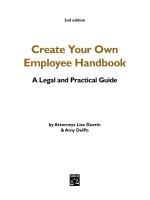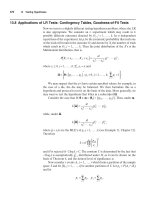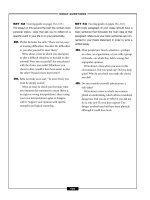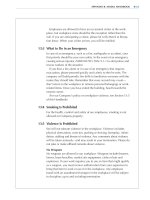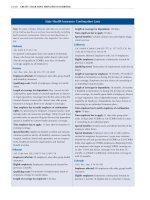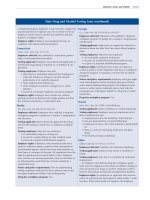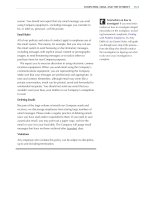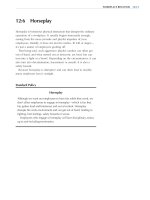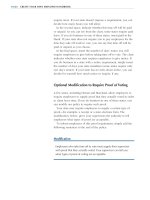create your own employee handbook a legal and practical guide phần 8 doc
Bạn đang xem bản rút gọn của tài liệu. Xem và tải ngay bản đầy đủ của tài liệu tại đây (445.29 KB, 49 trang )
DRUGS AND ALCOHOL 17/15
a treatment program. Employer is not, however, required to
provide paid leave. Employer may fire or refuse to hire an
employee whose drug or alcohol use interferes with job
duties or workplace safety.
Employee rights: Employer must safeguard privacy of
employee who enters treatment program.
Connecticut
Conn. Gen. Stat. Ann. § 31-51t
Employers affected: Any individual, corporation, partner-
ship or unincorporated association.
Testing applicants: Employer must inform job applicants in
writing that drug testing is required as a condition of em-
ployment.
Testing employees: Employer may test:
• when there is reasonable suspicion that employee is
under the influence of drugs or alcohol and job
performance is or could be impaired
• when authorized by federal law
• when employee’s position is dangerous or safety-
sensitive
• as part of a voluntary employee assistance program.
Employee rights: Employer may not take any adverse
personnel action on the basis of a single positive test that
has not been verified by a confirmation test.
Florida
Fla. Stat. Ann. §§ 440.101 to 440.102
Employers affected: Employers who establish a drug-free
workplace program to qualify for a workers’ compensation
rate discount.
Testing applicants: Must inform job applicants that drug
and alcohol testing is required as a condition of employ-
ment.
Testing employees: Must test any employee:
• on reasonable suspicion of drug use
• as part of a routine fitness-for-duty medical exam
• as part of a required rehabilitation program.
Employee rights: Employees who voluntarily seek treat-
ment for substance abuse cannot be fired, disciplined or
discriminated against, unless they have tested positive or
have been in treatment in the past. All employees have the
right to explain positive results within 5 days. Employer
may not take any adverse personnel action on the basis of
an initial positive result that has not been verified by a
confirmation test.
Notice and policy requirements: Prior to implementing
testing, employer must give 60 days’ advance notice and
must give employees written copy of drug policy.
Drug-free workplace program: Yes.
Georgia
Ga. Code Ann. §§ 34-9-410 to 34-9-421
Employers affected: Employers who establish a drug-free
workplace program to qualify for a workers’ compensation
rate discount.
Testing applicants: Applicants are required to submit to a
substance abuse test after they have been offered employ-
ment.
Testing employees: Must test any employee:
• on reasonable suspicion of drug use
• as part of a routine fitness-for-duty medical exam
• as part of a required rehabilitation program.
Employee rights: Employees have 5 days to explain or
contest a positive result. Employer must have an employee
assistance program or maintain a resource file of outside
programs.
Notice and policy requirements: Employer must give appli-
cants and employees notice of testing; must give 60 days’
notice before implementing program. All employees must
receive a written policy statement; policy must state the
consequences of refusing to submit to a drug test or of test-
ing positive.
Drug-free workplace program: Yes.
Hawaii
Haw. Rev. Stat. §§ 329B-1 and following
Testing applicants: Same conditions as current employees.
Testing employees: Employer may test employees only if
these conditions are met:
• employer pays all costs including confirming test
• tests are performed by a licensed laboratory
• employee receives a list of the substances being tested
for
• there is a form for disclosing medicines and legal
drugs
• the results are kept confidential.
Idaho
Idaho Code §§ 72-1701 to 72-1714
Employers affected: Voluntary for all private employers.
Testing applicants: Employer may test as a condition of
hiring.
Testing employees: May test as a condition of continued
employment.
An employer who follows drug-free workplace guide-
lines may fire employees who refuse to submit to testing or
who test positive for drugs or alcohol. Employees will be
fired for misconduct and denied unemployment benefits.
Employee rights: An employee or applicant who receives
notice of a positive test may request a retest within 7 work-
ing days. If the retest results are negative, the employer
State Drug and Alcohol Testing Laws (continued)
17/16 CREATE YOUR OWN EMPLOYEE HANDBOOK
must pay for the cost; if they are positive, the employee
must pay.
Drug-free workplace program: Yes (compliance is optional).
Illinois
775 Ill. Comp. Stat. § 5/2-104(C)(3)
Employers affected: Employers with 15 or more employees.
Testing employees: Employer may prohibit all employees
from using or being under the influence of alcohol and
illegal drugs. Employer may test employees who have been
in rehabilitation. Employee may be held to the same
standards as other employees, even if the unsatisfactory job
performance or behavior is due to drug use or alcoholism.
Indiana
Ind. Code Ann. §§ 22-9-5-6(b), 22-9-5-24
Employers affected: Employers with 15 or more employees.
Testing employees: Employer may prohibit all employees
from using or being under the influence of alcohol and ille-
gal drugs. Employer may test employees who have been in
rehabilitation. Employee may be held to the same standards
as other employees, even if the unsatisfactory job performance
or behavior is due to drug use or alcoholism.
Iowa
Iowa Code § 730.5
Employers affected: Employers with one or more full-time
employees.
Testing applicants: Employer may test as a condition of
hiring.
Testing employees: Employer may test employees:
• as a condition of continued employment
• upon reasonable suspicion
• during and after rehabilitation
• following an accident that caused a reportable injury
or more than $1,000 property damage.
Employee rights: Employee has 7 days to request a retest.
Employers with 50 or more employees must provide reha-
bilitation for any employee who has worked for at least
one year and has not previously violated the substance
abuse policy; no adverse action may be taken if employee
successfully completes rehabilitation. Employer must have
an employee assistance program or maintain a resource file
of outside programs.
Drug-free workplace program: Yes (compliance is optional).
Louisiana
La. Rev. Stat. Ann. §§ 49:1001 and following
Employers affected: Employers with one or more full-time
employees. (Does not apply to oil drilling, exploration or
production.)
Testing applicants: Employer may require all applicants to
submit to drug and alcohol test. Employer does not have to
confirm a positive result of a pre-employment drug screen,
but must offer the applicant the opportunity to pay for a
confirmation test and a review by a medical review officer.
Employee rights: Except for a pre-employment test, em-
ployer may not take adverse personnel action on the basis
of an initial screen. Employees with confirmed positive
results have 7 working days to request access to all records
relating to the drug test. Employer may allow employee to
undergo rehabilitation without termination of employment.
Maine
Me. Rev. Stat. Ann. tit. 26, §§ 681 to 690
Employers affected: Employers with one or more full-time
employees. (Law does not require or encourage employers
to conduct substance abuse testing.)
Testing applicants: Employer may require applicant to take
a drug test only if offered employment or placed on an
eligibility list.
Testing employees: Employer may test for probable cause,
but may not base belief on a single accident; must docu-
ment the facts and give employee a copy. May test when:
• there could be an unreasonable threat to the health
and safety of coworkers or the public
• an employee returns to work following a positive test.
Employee rights: Employee who tests positive has 3 days to
explain or contest results. Employee must be given an
opportunity to participate in a rehabilitation program for
up to 6 months; an employer with more than 20 full-time
employees must pay for half of any out-of-pocket costs.
After successfully completing the program, employee is
entitled to return to previous job with full pay and benefits.
Notice and policy requirements: All employers must have
a written policy approved by the state Department of Labor.
Policy must be distributed to each employee at least 30
days before it takes effect. Any changes to policy require
60 days advance notice. An employer with more than 20
full-time employees must have an employee assistance
program certified by the Office of Substance Abuse before
implementing a testing program.
Maryland
Md. Code Ann., [Health-Gen.] § 17-214
Employers affected: Law applies to all employers.
Testing applicants: May use preliminary screening to test
applicant. If initial result is positive, may make job offer
conditional on confirmation of test results.
Testing employees: Employer may require substance abuse
testing for legitimate business purposes only.
State Drug and Alcohol Testing Laws (continued)
DRUGS AND ALCOHOL 17/17
Employee rights: The sample must be tested by a certified
laboratory; at the time of testing employee may request
laboratory’s name and address. An employee who tests
positive must be given:
•a copy of the test results
•a copy of the employer’s written drug and alcohol
policy
• written notice of any adverse action employer intends
to take
• statement of employee’s right to an independent
confirmation test at own expense.
Minnesota
Minn. Stat. Ann. §§ 181.950 to 181.957
Employers affected: Employers with one or more full-time
employees. (Employers are not required to test.)
Testing applicants: Employers may require applicants to
submit to a drug or alcohol test only after they have been
given a job offer and have seen a written notice of testing
policy. May only test if required of all applicants for same
position.
Testing employees: Employers may require drug or alcohol
testing only according to a written testing policy. Testing
may be done if there is a reasonable suspicion that employee:
• is under the influence of drugs or alcohol
• has violated drug and alcohol policy
• has been involved in an accident
• has sustained or caused another employee to sustain a
personal injury. Random tests permitted only for
employees in safety-sensitive positions. With 2 weeks’
notice, employers may also test as part of an annual
routine physical exam.
Employee rights: If test is positive, employee has 3 days to
explain the results; employee must notify employer within
5 days of intention to obtain a retest. Employer may not
discharge employee for a first-time positive test without
offering counseling or rehabilitation; employee who refuses
or does not complete program successfully may be dis-
charged.
Notice and policy requirements: Employees must be given
a written notice of testing policy which includes conse-
quences of refusing to take test or having a positive test
result. 2 weeks’ notice required before testing as part of an
annual routine physical exam.
Mississippi
Miss. Code Ann. §§ 71-7-1 and following; 71-3-205 and
following
Employers affected: Employers with one or more full-time
employees. Employers who establish a drug-free workplace
program to qualify for a workers’ compensation rate dis-
count must implement testing procedures.
Testing applicants: May test (must test, if drug-free work-
place) all applicants as part of employment application
process. Employer may request a signed statement that
applicant has read and understands the drug and alcohol
testing policy and/or notice.
Testing employees: May (must, if drug-free workplace) re-
quire drug and alcohol testing of all employees:
• on reasonable suspicion
• as part of a routinely scheduled fitness for duty
medical examination
• as a follow-up to a rehabilitation program
• who have tested positive within the previous 12
months.
Employee rights: Employer must inform an employee in
writing within 5 working days of receipt of a positive
confirmed test result; employee may request and receive a
copy of the test result report. Employee has 10 working
days after receiving notice to explain the positive test
results. Private employer who elects to establish a drug-free
workplace program must have an employee assistance
program or maintain a resource file of outside programs.
Notice and policy requirements: 30 days before imple-
menting testing program employer must give employees
written notice of drug and alcohol policy which includes
consequences
• of a positive confirmed result
• of refusing to take test
• of other violations of the policy.
Drug-free workplace program: Yes.
Montana
Mont. Code Ann. §§ 39-2-205 to 39-2-211
Employers affected: Employers with one or more employees.
Testing applicants: May test as a condition of hire.
Testing employees: Employees may be tested:
• on reasonable suspicion
• after involvement in an accident that causes personal
injury or more than $1,500 property damage
• as a follow-up to a previous positive test
• as a follow-up to treatment or a rehabilitation
program.
Employer may conduct random tests as long as there is
an established date and all personnel are subject to testing.
Employer may require an employee who tests positive to
undergo treatment as a condition of continued employment.
Employee rights: After a positive result, employee may
request additional confirmation by an independent labora-
tory; if the results are negative, employer must pay the test
costs.
Notice and policy requirements: Written policy must be
available for review 60 days before testing.
State Drug and Alcohol Testing Laws (continued)
17/18 CREATE YOUR OWN EMPLOYEE HANDBOOK
Nebraska
Neb. Rev. Stat. §§ 48-1901 and following
Employers affected: Employers with 6 or more full-time
and part-time employees.
Testing employees: Employer may require employees to
submit to drug or alcohol testing and may discipline or
discharge any employee who refuses.
Employee rights: Employer may not take adverse action on
the basis of an initial positive result unless it is confirmed
according to state and federal guidelines.
Nevada
Nev. Rev. Stat. Ann. § 608.156
Employers affected: All employers who offer health benefits.
Employee rights: Employee health benefits must include
treatment for drug or alcohol abuse. Limits are: $1,500 per
year for treatment for withdrawal; $9,000 per year for in-
patient facility; $2,500 for outpatient counseling. Maximum
of $39,000 per lifetime.
North Carolina
N.C. Gen. Stat. §§ 95-230 to 95-235
Employers affected: Law applies to all employers.
Testing employees: Employer must preserve samples for at
least 90 days after confirmed test results are released.
Employee rights: Employee has right to retest a confirmed
positive sample at own expense.
North Dakota
N.D. Cent. Code § 34-01-15
Employers affected: Any employer who requires a medical
exam as a condition of hire or continued employment may
include a drug or alcohol test.
Testing employees: Employer may test following an accident
or injury that will result in a workers’ compensation claim:
if employer has a mandatory policy of testing under these
circumstances, or if employer or physician has reasonable
grounds to suspect injury was caused by impairment due to
alcohol or drug use.
Ohio
Ohio Admin. Code §§ 4123-17-58, 4123-17-58.1
Employers affected: Employers who establish a drug-free
workplace program to qualify for a workers’ compensation
rate discount.
Testing applicants: Must test all applicants and new hires
within at least 90 days of employment.
Testing employees: Must test employees:
• on reasonable suspicion
• following a return to work after a positive test
• after an accident which results in an injury requiring
offsite medical attention or property damage over
limit specified in drug and alcohol policy.
Employee rights: Employer must have an employee assis-
tance plan. Employer must offer healthcare coverage which
includes chemical dependency counseling and treatment.
Notice and policy requirements: Policy must state conse-
quences for refusing to submit to testing or for violating
guidelines. Policy must include a commitment to rehabili-
tation.
Drug-free workplace program: Yes.
Oklahoma
Okla. Stat. Ann. tit. 40, §§ 551 to 565
Employers affected: Employers with one or more employees.
(Drug or alcohol testing not required or encouraged.)
Testing applicants: Employer may test applicants as a
condition of employment; may refuse to hire applicant
who refuses to undergo test or has a confirmed positive
result.
Testing employees: Before requiring testing employer must
provide an employee assistance program. Random testing
is allowed. May test employees:
• on reasonable suspicion
• after an accident resulting in injury or property
damage over $500
• as part of a routine fitness-for-duty examination
• or as follow-up to a rehabilitation program.
Employee rights: Employee has right to retest a positive
result at own expense; if the confirmation test is negative
employer must reimburse costs.
Notice and policy requirements: Before requiring testing
employer must:
• adopt a written policy
• give a copy to each employee and to any applicant
offered a job
• allow 30 days’ notice.
Oregon
Or. Rev. Stat. §§ 659.840; 659A.300; 438.435
Employers affected: Law applies to all employers.
Testing applicants: Unless there is reasonable suspicion
that an applicant is under the influence of alcohol, no
employer may require a breathalyzer test as a condition of
employment. Employer is not prohibited from conducting a
test if applicant consents.
Testing employees: Unless there is reasonable suspicion
that an employee is under the influence of alcohol, no
employer may require a breathalyzer or blood alcohol test
as a condition of continuing employment. Employer is not
prohibited from conducting a test if employee consents.
State Drug and Alcohol Testing Laws (continued)
DRUGS AND ALCOHOL 17/19
Employee rights: No action may be taken based on the
results of an on-site drug test without a confirming test
performed according to state Health Division regulations.
Upon written request test results will be reported to the
employee.
Rhode Island
R.I. Gen. Laws §§ 28-6.5-1 to 28-6.5-2
Employers affected: Law applies to all employers.
Testing employees: May require employee to submit to a
drug test only if there are reasonable grounds, based on
specific observations, to believe employee is using con-
trolled substances that are impairing job performance.
Employee rights: Employee who tests positive may have
the sample retested at employer’s expense and must be
given opportunity to explain or refute results. Employee
may not be terminated on the basis of a positive result, but
must be referred to a licensed substance abuse professional.
After referral employer may require additional testing; may
terminate employee if test results are positive.
South Carolina
S.C. Code Ann. §§ 41-1-15; 38-73-500
Employers affected: Employers who establish a drug-free
workplace program to qualify for a workers’ compensation
rate discount.
Testing employees: Must conduct random testing among
all employees. Must conduct a follow-up test within 30
minutes of the first test.
Employee rights: Employee must receive positive test
results in writing within 24 hours.
Notice and policy requirements: Employer must notify all
employees of the drug-free workplace program at the time
it is established or at the time of hiring, whichever is earlier.
Program must include a policy statement that balances
respect for individuals with the need to maintain a safe,
drug-free environment
Drug-free workplace program: Yes.
Tennessee
Tenn. Code Ann. §§ 50-9-101 and following
Employers affected: Employers who establish a drug-free
workplace program to qualify for a workers’ compensation
rate discount.
Testing applicants: Must test applicants upon conditional
offer of employment. Job ads must include notice that drug
and alcohol testing required.
Testing employees: Employer must test upon reasonable
suspicion; must document behavior on which the suspicion
is based within 24 hours or before test results are released,
whichever is earlier, and must give a copy to the employee
upon request. Employer must test employees:
• who are in safety-sensitive positions
• as part of a routine fitness-for-duty medical exam
• after an accident that results in injury
• as a follow-up to a required rehabilitation program.
Employee rights: Employee has the right to explain or con-
test a positive result within 5 days. Employee may not be
fired, disciplined or discriminated against for voluntarily
seeking treatment unless employee has previously tested
positive or been in a rehabilitation program.
Notice and policy requirements: Before implementing test-
ing program, employer must provide 60 days’ notice and
must give all employees a written drug and alcohol policy
statement.
Drug-free workplace program: Yes.
Texas
Tex. Lab. Code Ann. § 411.091
Employers affected: Employers with 15 or more employees
who have a workers’ compensation insurance policy.
Notice and policy requirements: Must adopt a drug abuse
policy and provide a written copy to employees.
Utah
Utah Code Ann. §§ 34-38-1 to 34-38-15
Employers affected: Employers with one or more employees.
Testing applicants: Employer may test any applicant for
drugs or alcohol as long as management also submits to
periodic testing.
Testing employees: Employer may test employee for drugs
or alcohol as long as management also submits to periodic
testing. Employer may also require testing to:
• investigate an accident or theft
• maintain employee or public safety
• ensure productivity, quality or security.
Employee rights: Employer may suspend, discipline, dis-
charge or require treatment on the basis of a confirmed
positive test result.
Notice and policy requirements: Testing must be conducted
according to a written policy that has been distributed to
employees and is available for review by prospective
employees.
Vermont
Vt. Stat. Ann. tit. 21, §§ 511 and following.
Employers affected: Employers with one or more employees.
Testing applicants: Employer may not test applicants for
drugs or alcohol unless there is a job offer conditional on a
negative test result, and a written notice of the testing
procedure and a list of the drugs to be tested.
State Drug and Alcohol Testing Laws (continued)
17/20 CREATE YOUR OWN EMPLOYEE HANDBOOK
Testing employees: Random testing not permitted unless
required by federal law. Employer may not require testing
unless:
• there is probable cause to believe an employee is
using or is under the influence
• employer has an employee assistance program which
provides rehabilitation
• employee who tests positive and agrees to enter
employee assistance program is not terminated.
Employee rights: Employer must contract with a medical
review officer who will review all test results and keep them
confidential. Medical review officer to contact employee or
applicant to explain a positive test result. Employee or
applicant has right to an independent retest at own expense.
State Drug and Alcohol Testing Laws (continued)
Employee who successfully completes employee assistance
program may not be terminated, although employee may
be suspended for up to 3 months to complete program.
Employee who tests positive after completing treatment
may be fired.
Virginia
Va. Code Ann. § 65.2-813.2
Employers affected: Employers who establish drug-free
workplace programs to qualify for workers’ compensation
insurance discount.
Drug-free workplace program: State law gives insurers the
authority to establish guidelines and criteria for testing.
Current as of February 2003
■
CHAPTER
18
Trade Secrets and Conflicts
of Interest
More often than not, what gives your business a competitive
advantage is the specialized knowledge that it has gained through
ingenuity, innovation or just plain hard work. This specialized
knowledge could be something as mundane as a list of customers
who have a specific need for your services or as glamorous as the
top secret formula for your product, from a cookie recipe to an in-
dustrial chemical. The law of trade secrets protects this specialized
knowledge from disclosure to, and use by, your competitors.
Employees pose a thorny dilemma for businesses with valuable
trade secrets. After all, you have to let some of these people in on
your trade secrets—either because they need the information to do
their jobs or because they helped you develop the information in
the first place. Yet these same people may harm your business—
either accidentally or through bad intentions—by revealing your
trade secrets to competitors.
Most states have laws that impose on employees a duty of loyalty
to their employer, and this duty includes keeping mum about trade
secrets. Nonetheless, it doesn’t hurt to specifically inform employ-
ees in your handbook that you expect them to keep confidential
any information they learn through their employment with you.
A similar issue arises with regard to conflicts of interest. Most
employers do not want their current employees also working for
competitors. Such work inherently divides an employee’s loyalties
and creates a risk that the employee will reveal trade secrets to the
competitor. By the same token, such work creates the risk that the
employee will reveal the competitor’s trade secrets to you. Although
having a double agent on your team might not sound so bad at
first, it’s illegal—and your competitor could drag you into court if it
suspected you were learning its valuable trade secrets.
18/2 CREATE YOUR OWN EMPLOYEE HANDBOOK
One of the first steps in protecting yourself is to put your
employees on notice about what you expect. We designed the
following policies to do just that:
18:1 Confidentiality and Trade Secrets 18/3
18:2 Conflicts of Interest 18/6
If you have valuable informa-
tion that you want to protect,
you’ll need a lot more than a few
handbook policies to do the job. You’ll
need policies and procedures in place
to identify confidential information
and to limit access to it, among other
things. For basic information about
trade secrets and employees, including
a discussion of what trade secrets are
and how you can protect them, see
Chapter 10 of Everyday Employment
Law: The Basics,
by Lisa Guerin &
Amy DelPo (Nolo).
TRADE SECRETS AND CONFLICTS OF INTEREST 18/3
18:1 Confidentiality and
Trade Secrets
Often, ensuring that your employees don’t disclose your sensitive
information is as simple as cluing them in to the importance of
keeping quiet and alerting them to the consequences of failing to
do so. This policy does just that.
Standard Policy
Confidentiality and Trade Secrets
Information is part of what makes this Company competitive.
During your employment here, you will periodically learn sensitive
information, either because you help to develop that information or
because you need that information to do your job. It is important
for the health of this business—and for the well-being of employees
who depend on this business for their livelihood—that you keep
information you learn through your employment confidential. Em-
ployees who improperly disclose sensitive information, confidential
information, proprietary information or trade secret information to
anyone outside the Company will face disciplinary action, up to
and including termination. Therefore, we encourage you to contact
if you would like to learn
more about this policy or if you have any questions.
After you leave this Company, you are still legally prohibited
from disclosing sensitive, proprietary, trade secret or confidential
information. If you disclose such information, we will seek legal
remedies.
18/4 CREATE YOUR OWN EMPLOYEE HANDBOOK
Reality Check: Use Confidentiality Agreements
and Designate Confidential Information
As you read the policy, notice that it raises more questions than it
answers. What information qualifies as “sensitive information,
confidential information, proprietary information or trade secret
information”? What does it mean to “improperly disclose” such
information? Unfortunately, your handbook cannot answer these
questions for your employees; only you can—through training,
procedures and practices. If your business depends on trade secret
information to keep a competitive advantage, it behooves you to
develop confidentiality procedures to protect your valuable infor-
mation from disclosure. These procedures typically include fairly
simple means—such as labeling certain documents as “confidential”—
of informing employees about what information is confidential and
what information isn’t.
In addition, it is important to remember that your handbook is
not a contract. It does not bind you, and it does not bind your
employees. This means that you cannot go to court to enforce the
provisions in the handbook. If you have employees who will learn
or develop sensitive information while working for you, consider
having them sign a confidentiality agreement (also called a nondis-
closure agreement). Although the duty of loyalty that we mentioned
above should be technically sufficient to protect your trade secrets,
nondisclosure agreements underscore the importance of confidenti-
ality and clear up any ambiguity about what information you con-
sider a trade secret. They can also be helpful if you ever have to
haul an employee into court for revealing a trade secret, whether
the employee is still working for you or not.
Optional Modification for Employers With
Confidentiality Procedures in Place
If you have procedures in place to protect your confidential infor-
mation, pat yourself on the back. Then modify the standard policy
above to inform employees of this fact. You don’t need to give
exhaustive detail about the procedures. It is sufficient to alert
employees to their existence and to tell employees where they can
go for more information. Consider adding the following paragraph
to the standard policy, above:
To learn how to create your
own confidentiality agreements,
see Nondisclosure Agreements:
Protect Your Trade Secrets & More,
by Richard Stim & Stephen Fishman
(Nolo).
TRADE SECRETS AND CONFLICTS OF INTEREST 18/5
Modification
Because of the grave importance of keeping certain information
confidential, this Company follows practices designed to alert
employees to sensitive and confidential information, to limit access
to that information and to inform employees about what disclosures
are and are not acceptable. We expect employees to follow these
procedures. Employees who fail to do so face discipline, up to and
including termination. To find out more about these procedures,
refer to
. If you have any questions
about these procedures, contact .
This policy only applies to
current employees; it does not
prohibit former employees from
working for competitors. No hand-
book policy can do that. Instead,
you’ll need to use a contract called a
noncompete agreement. To learn
how to create your own noncompete
agreements, see How to Create a
Noncompete Agreement, by Shannon
Miehe (Nolo).
18/6 CREATE YOUR OWN EMPLOYEE HANDBOOK
18:2 Conflicts of Interest
You probably want and expect your employees to be loyal to you
and not to your competitors. You’re a team, after all. You and your
employees work together to compete in the marketplace and to
create a healthy, thriving business.
In most instances, the fact that an employee has a little job on
the side isn’t going to do much—if any—damage to your business.
If that job is with a competitor, however, the risk arises that the job
will divide your employee’s loyalties.
Similarly, investments will pose little harm to your company,
unless those investments make the employees act in a way that is
contrary to your company’s interests.
This policy tells employees that loyalty is part of their job
description—and it informs them that they will face consequences
if they act in ways that could harm the company.
Conflicts of interest or free-
dom of choice? Although you
have a legal right to protect your
business against conflicts of interest,
your employees also have rights—to
invest as they see fit and to work for
whomever they want. The law bal-
ances your rights against those of your
employees. If you need to discipline
or terminate someone for violating
this policy, consult with an attorney
first to make sure that your actions
don’t violate laws designed to protect
your employees.
TRADE SECRETS AND CONFLICTS OF INTEREST 18/7
Standard Policy
Conflicts of Interest
Our Company’s success depends on the hard work, dedication and
integrity of everyone who works here. In turn, our employees’ live-
lihood depends on the success of our Company.
Because we depend so much on our employees, and because
they depend so much on us, we expect all employees to devote their
energies and loyalties to our Company. We do not allow employees
to engage in any activities or relationships that create either an
actual conflict of interest or the potential for a conflict of interest.
Although we cannot list every activity or relationship that would
create either an actual or potential conflict of interest, examples of
activities that violate this policy include the following:
•working for a competitor or customer or vendor as a part-time
employee, full-time employee, consultant, independent
contractor or in any other capacity
•owning an interest in a competitor, customer, vendor or any-
one else who seeks to do business with this Company
• using the resources of this Company for personal gain
• using your position in this Company for personal gain.
Employees who violate this policy face disciplinary action, up to
and including termination.
If you are unsure about whether an activity might violate this
policy, or if you have any questions at all about this policy, please
talk to .
■
CHAPTER
19
Discrimination and Harassment
Most employers are required to follow federal anti-discrimination
laws, including laws prohibiting sexual harassment. Depending on
where you do business, you may also have to follow state and
even local laws banning discrimination. Your obligation to comply
with these laws has nothing to do with your personnel policies—
whether you have an anti-discrimination policy or not, you must
follow the rules.
So why have anti-discrimination and anti-harassment policies in
your handbook? First, these policies educate your employees and
your managers about what constitutes discrimination or harassment,
what types of conduct are prohibited and what your company will
do to stop it. Armed with this information, your employees and
managers will know what to do if they are victims of, or witnesses
to, illegal behavior. And they will know that your company believes
in equal employment opportunity for everyone, a philosophy that
can help you build solid relations with your workers.
Second, anti-discrimination and anti-harassment policies will
encourage your workers to bring misconduct to your attention
immediately. Unless you run a very small company or spend all of
your time walking the shop floor, this could be the only way that you
learn when a potentially troublesome situation is brewing. If your
employees complain quickly, you have a chance to deal with the
problems right away, before they poison the workplace environment.
Finally, a well-crafted anti-harassment policy buys you some
legal protection, should you find yourself dragged into court by an
employee. If you have a clear written policy prohibiting harassment,
your employees must follow the procedures you outline to make
complaints. If they fail to alert you to a problem, courts might not
let them sue you for failing to deal with it.
We address the following policies in this chapter:
19:1 Anti-Discrimination Policy 19/2
19:2 Harassment 19/6
19/2 CREATE YOUR OWN EMPLOYEE HANDBOOK
19:1 Anti-Discrimination Policy
Your anti-discrimination policy should explain your company’s
commitment to equal opportunity. It should describe what is
prohibited, let employees know what to do if they witness or
suffer discrimination and tell employees how the company will
deal with discrimination in the workplace.
Standard Policy
Our Commitment to Equal Employment Opportunity
[Company name] is strongly committed to providing equal employ-
ment opportunity for all employees and all applicants for employment.
For us, this is the only acceptable way to do business.
All employment decisions at our Company—including those
relating to hiring, promotion, transfers, benefits, compensation,
placement and termination—will be made without regard to
[
prohibited bases for discrimination ].
Any employee or applicant who believes that he or she has been
discriminated against in violation of this policy should immediately
file a complaint with
, as explained in our
Complaint Policy. We encourage you to come forward if you have
suffered or witnessed what you believe to be discrimination—we
cannot solve the problem until you let us know about it. The Company
will not retaliate, or allow retaliation, against any employee or
applicant who complains of discrimination, assists in an investigation
of possible discrimination or files an administrative charge or lawsuit
alleging discrimination.
Managers are required to report any discriminatory conduct or
incidents, as described in our Complaint Policy.
Our Company will not tolerate discrimination against any
employee or applicant. We will take immediate and appropriate
disciplinary action against any employee who violates this policy.
Who Needs This Policy
No law requires you to include an anti-discrimination policy in
your handbook. Because of the benefits such a policy can provide,
however, all employers who are subject to anti-discrimination laws
DISCRIMINATION AND HARASSMENT 19/3
should have one (you can find details on which employers have a
legal obligation not to discriminate below).
How to Complete This Policy
There are two things you will have to figure out in order to fill in
the blanks, above. First, you need to know what anti-discrimination
laws you are required to follow—this will tell you what to put in
the first blank, where you need to list prohibited bases for discrimi-
nation. Federal laws require many employers not to discriminate
on the basis of race, color, national origin, religion, sex, age,
disability or citizenship status. However, these laws don’t apply to
every employer—only to employers who have a specified minimum
number of employees, as explained below.
In addition, most states and some municipalities have their own
anti-discrimination laws. Some of these laws duplicate the federal
protections, others apply to smaller employers or prohibit discrimi-
nation based on characteristics the feds left out—such as marital
status or sexual orientation. To find out which federal laws you
have to follow—and therefore, which characteristics to list in your
policy—refer to “Which Federal Anti-Discrimination Laws Apply to
Your Company,” below. To find out whether your state imposes
any additional obligations on you, consult the chart entitled “Laws
Prohibiting Discrimination in Employment” at the end of this chapter.
You can find out whether any local laws apply to you by getting in
touch with your state fair employment department (see Appendix
C for contact information) or your local Chamber of Commerce.
For more information on
federal anti-discrimination
laws, see Federal Employment Laws:
A Desk Reference, by Amy DelPo &
Lisa Guerin (Nolo). This helpful
resource devotes an entire chapter to
each of the major federal employment
laws, including the anti-discrimination
laws listed above.
19/4 CREATE YOUR OWN EMPLOYEE HANDBOOK
Which Federal Anti-Discrimination Laws
Apply to Your Company
Not every anti-discrimination law applies to every employer. For
the most part, whether you have to follow these laws depends on
the size and location of your company. Federal anti-discrimination
laws (listed below) apply only to employers with more than a mini-
mum number of employees—and this minimum number is different
for each law.
Name of Law:
Discrimination Prohibited
on the Basis of: Applies to:
Title VII Race, national origin,
religion, sex
Employers with 15
or more employees
Age Discrimination
in Employment Act
Age (over 40 only) Employers with 20
or more employees
Americans with
Disabilities Act
Physical or mental
disability
Employers with 15
or more employees
Equal Pay Act Sex (applies only to wage
discrimination)
All Employers
Civil Rights Act of
1866
Race All Employers
Immigration Reform
and Control Act
Citizenship status, national
origin
Employers with 4 or
more employees
Your handbook should refer only to those types of discrimination
that are prohibited for your company. For example, if you do busi-
ness in a state that outlaws discrimination based on sexual orienta-
tion, you should include sexual orientation in the list of prohibited
bases for discrimination. Similarly, if your business has only 15
employees, you do not have to comply with the Age Discrimination
in Employment Act—and you should not include age in your list.
The second thing you will have to decide is who should take
complaints of discrimination. In this space, designate the person or
persons whom you name in your complaint policy (see Chapter 20).
If you have a human resources department, you can refer employees
there.
Optional Modification Emphasizing
Company’s Commitment
You may want to include additional language explaining your
commitment to equal employment opportunity. Some employers
take special pride in their efforts to combat discrimination, to pro-
DISCRIMINATION AND HARASSMENT 19/5
vide goods or services to traditionally underserved communities or
to honor cultural diversity.
SAMPLE POLICY LANGUAGE:
Our Company was founded to help women achieve equal
opportunity in the field of sports. This commitment to equal op-
portunity for everyone extends to our workplace and the way we
treat each other. Discrimination of any kind is contrary to the
principles our Company stands for.
SAMPLE POLICY LANGUAGE: A company that imports ethnic food
products might add:
Our mission is to bring fresh, high-quality food products from
around the world to customers in the United States. We take
pride in the great diversity of our customers and of our employees.
We treat our employees, and expect our employees to treat each
other, with respect and dignity. Discrimination of any kind is
against our Company philosophy and policies, and will not be
tolerated.
19/6 CREATE YOUR OWN EMPLOYEE HANDBOOK
19:2 Harassment
Legally, harassment is a form of discrimination. The same laws that
prohibit discrimination also require employers to stop harassment.
Therefore, every employer who is subject to the anti-discrimination
laws discussed above should also have a harassment policy.
No law requires you to have a harassment policy. However, in
addition to the practical benefits such a policy can provide, a
harassment policy gives you one very substantial legal benefit:
protection against certain harassment lawsuits. If you have a
harassment policy that includes the essential elements we discuss
below (and include in our sample policy), and you fully and fairly
investigate complaints of harassment, an employee who fails to
complain of harassment may not be allowed to sue you.
This protection applies only to certain types of harassment cases,
however. If you were aware of the harassment even though the
employee did not complain (for example, there were lewd posters
and X-rated graffiti displayed prominently throughout the workplace),
the employee’s failure to complain won’t get you off the hook.
And if the harassment was committed by a manager or supervisor
and resulted in a serious, negative job action against the employee
(for example, the employee was fired or denied a promotion because
she refused to have a sexual relationship with a supervisor), you
will be responsible whether or not the employee complained.
However, if no negative job action was taken against the employee
(for example, an employee was repeatedly teased or subjected to
lewd jokes and stories, but was not demoted or fired), she can sue
you for harassment by a manager or supervisor only if she first
complained to you, using your harassment and complaint policies.
Your harassment policy should explain what harassment is, let
workers know that harassment will not be tolerated, tell workers
and managers what to do if they witness or suffer harassment and
assure everyone that retaliation against those who complain of
harassment or participate in a harassment investigation is strictly
prohibited.
DISCRIMINATION AND HARASSMENT 19/7
Standard Policy
Harassment Will Not Be Tolerated
It is our policy and our responsibility to provide our employees
with a workplace free from harassment. Harassment on the basis of
[
prohibited bases for discrimination] undermines our workplace
morale and our commitment to treat each other with dignity and
respect. Accordingly, harassment will not be tolerated at our
Company.
Harassment can take many forms, including but not limited to
touching or other unwanted physical contact, posting offensive
cartoons or pictures, using slurs or other derogatory terms, telling
offensive or lewd jokes and stories and sending email messages
with offensive content. Unwanted sexual advances, requests for
sexual favors and sexually suggestive gestures, jokes, propositions,
email messages or other communications all constitute harassment.
If you experience or witness any form of harassment in the work-
place, please immediately notify the company by following the
steps outlined in our Complaint Policy (see Section
of this
Handbook). We encourage you to come forward with complaints—
the sooner we learn about the problem, the sooner we can take
steps to resolve it. The Company will not retaliate, or allow retalia-
tion, against anyone who complains of harassment, assists in a
harassment investigation or files an administrative charge or lawsuit
alleging harassment. All managers are required to immediately
report any incidents of harassment, as set forth in our Complaint
Policy.
Complaints will be investigated quickly. Those who are found to
have violated this policy will be subject to appropriate disciplinary
action, up to and including termination.
How to Complete This Policy
Because harassment is legally considered to be a type of discrimi-
nation, your obligation to prevent and remedy harassment tracks
your obligation not to discriminate—for example, if the law protects
your employees from discrimination on the basis of race, they are
also protected from racial harassment. In the blank space, fill in the
same prohibited bases for harassment that you included in your
anti-discrimination policy.
19/8 CREATE YOUR OWN EMPLOYEE HANDBOOK
Laws Prohibiting Discrimination in Employment
Private employers may not make employment decisions based on
State
Law
applies to
employers
with
Age
Ancestry or national origin
Disability
AIDS/HIV
Gender
Marital
status
Pregnancy,
childbirth and
related medical
conditions
Race or color
Religion or creed
Sexual orientation
Genetic testing information
Additional protected
categories
Alabama
Ala. Code §§ 21-7-1;
25-1-20
20 or more
employees
40
and
older
Alaska
Alaska Stat.
§§ 18.80.220;
47.30.865
One or
more
employees
40
and
older
✓
Physical
and mental
✓✓
✓
(Includes
changes in
status)
✓
Parenthood
✓✓
Mental illness
Arizona
Ariz. Rev. Stat.
§ 41-1461
15 or more
employees
40
and
older
✓
Physical
✓✓ ✓✓ ✓
Arkansas
Ark. Code Ann.
§§ 16-123-101;
11-4-601; 11-5-403
9 or more
empl
oyees
✓
Physical,
mental and
sensory
✓✓ ✓✓✓
1
California
Cal. Gov’t. Code
§§ 12920,12941; Cal.
Lab. Code § 1101
5 or more
employees
40
and
older
✓
Physical
and mental
✓✓✓ ✓ ✓✓✓✓
•
Medical condition
•
Political activities or
affi liations
Colorado
Colo. Rev. Stat.
§§ 24-34-301,
24-34-401; 27-10-115
Law applies
to all
employers.
40 to
70
✓
Physical,
mental and
learning
✓✓ ✓ ✓✓
•
Lawful conduct
outside of work
•
Mental illness
Connecticut
Conn. Gen. Stat. Ann.
§§ 46a-51, 46a-60
3 or more
employees
40
and
older
✓
Present or
past physi-
cal, mental
or learning
✓✓✓ ✓ ✓✓ ✓
Mental retardation
Delaware
Del. Code Ann. tit. 19,
§ 710
4 or more
employees
40 to
70
✓
Physical or
mental
✓✓✓ ✓ ✓✓ ✓
District of
Columbia
D.C. Code Ann.
§§ 2-1401.01;
7-1703.03
Law applies
to all
employers.
18
and
older
✓
Physical or
mental
✓✓✓
✓
Parenthood
✓✓✓
•
Enrollment in
vocational or
professional or
college education
•
Family duties
•
Perceived race
•
Personal
appearance
•
Political affi liation
•
Smoker
Florida
Fla. Stat. Ann.
§§ 760.01, 760.50;
448.075
15 or more
employees
No
age
limit
✓
“Handicap”
✓✓✓ ✓✓
Sickle cell trait
1
Employees covered by FLSA
DISCRIMINATION AND HARASSMENT 19/9
Laws Prohibiting Discrimination in Employment (continued)
Private employers may not make employment decisions based on
State
Law
applies to
employers
with
Age
Ancestry or national origin
Disability
AIDS/HIV
Gender
Marital
status
Pregnancy,
childbirth and
related medical
conditions
Race or color
Religion or creed
Sexual orientation
Genetic testing information
Additional protected
categories
Georgia
Ga. Code Ann.
§§ 34-6A-1; 34-1-23;
34-5-1
15 or more
employees
(disability)
10 or more
employees
(gender)
40 to
70
Physical or
mental
✓
2
Hawaii
Haw. Rev. Stat. § 378-1
One or
more
employees
No
age
limit
✓
Physical or
mental
✓✓✓ ✓
Breastfeeding
✓✓✓ ✓
Arrest and court re-
cord (unless there is
a conviction directly
related to job)
Idaho
Idaho Code
§ 67-5909
5 or more
employees
40
and
older
✓
Physical or
mental
✓
✓✓✓
Illinois
775 Ill. Comp. Stat.
§§ 5/1-101, 5/2-101;
Ill. Admin. Code tit.
56, § 5210.110
15 or more
employees
40
and
older
✓
Physical or
mental
✓
✓
✓✓ ✓✓
•
Arrest record
•
Citizen status
•
Military status
•
Unfavorable
military discharge
Indiana
Ind. Code Ann. §§ 22-
9-1-1,
22-9-2-1
6 or more
employees
40 to
70
✓
Physical or
mental
✓
✓✓
Iowa
Iowa Code § 216.1
4 or more
employees
18 or
older
✓
Physical or
mental
✓
✓
✓✓✓
Kansas
Kan. Stat. Ann.
§§ 44-1001, 44-1111,
44-1125; 65-6002(e)
4 or more
employees
18 or
older
✓
Physical or
mental
✓
✓
✓✓ ✓
Military status
Kentucky
Ky. Rev. Stat. Ann.
§§ 344.040; 207.130;
342.197
8 or more
employees
40 or
older
✓
Physical
(Includes
black lung
disease)
✓
✓
✓✓
Smoker or non-
smoker
Louisiana
La. Rev. Stat. Ann.
§§ 23:301 to 23:352
20 or more
employees
40 or
older
✓
Physical or
mental
✓
✓
(Applies to employ-
ers with 25 or more
employees)
✓✓ ✓
Sickle cell trait
Maine
Me. Rev. Stat. Ann. tit.
5, §§ 4551, 4571
Law applies
to all
employers.
No
age
limit
✓
Physical or
mental
✓✓ ✓✓✓ ✓
Maryland
Md. Code 1957 Art.
49B, § 15
15 or more
employees
No
age
limit
✓
Physical or
mental
✓✓ ✓ ✓✓✓ ✓
2
Wage discrimination only
19/10 CREATE YOUR OWN EMPLOYEE HANDBOOK
Laws Prohibiting Discrimination in Employment (continued)
Private employers may not make employment decisions based on
State
Law
applies to
employers
with
Age
Ancestry or national origin
Disability
AIDS/HIV
Gender
Marital
status
Pregnancy,
childbirth and
related medical
conditions
Race or color
Religion or creed
Sexual orientation
Genetic testing information
Additional protected
categories
Massachusetts
Mass. Gen. Laws ch.
151B, § 4
6 or more
employees
40 or
older
✓
Physical or
mental
✓✓ ✓✓✓ ✓
Michigan
Mich. Comp. Laws
§§ 37.1201, 37.2201,
37.1103
One or
more
employees
No
age
limit
✓
Physical or
mental
✓✓✓ ✓ ✓✓ ✓
•
Height or weight
•
Arrest record
Minnesota
Minn. Stat. Ann.
§§ 363.01; 181.974
One or
more
employees
18 or
older
✓
Physical or
mental
✓✓✓ ✓ ✓✓✓✓
•
Member of local
commission
•
Perceived sexual
orientation
•
Receiving public
assistance
Mississippi
No state law
Missouri
Mo. Rev. Stat.
§§ 213.010; 191.665;
375.1306
6 or more
employees
40 to
70
✓
Physical or
mental
✓✓ ✓ ✓✓ ✓
Montana
Mont. Code Ann.
§§ 49-2-101,
49-2-303
One or
more
employees
No
age
limit
✓
Physical or
mental
✓✓ ✓✓
Nebraska
Neb. Rev. Stat.
§§ 48-1101; 48-1001;
20-168
15 or more
employees
40 to
70
3
✓
Physical or
mental
✓✓✓ ✓ ✓✓ ✓
Nevada
Nev. Rev. Stat. Ann.
§ 613.310 and
following
15 or more
employees
40 or
older
✓
Physical or
mental
✓✓ ✓✓✓ ✓
Lawful use of any
product when not at
work
New Hampshire
N.H. Rev. Stat. Ann.
§§ 354-A:2 and
following; 141-H:3
6 or more
employees
No
age
limit
✓
Physical or
mental
✓✓ ✓ ✓✓✓ ✓
New Jersey
N.J. Stat. Ann.
§§ 10:5-1; 34:6B-1
Law applies
to all
employers.
18 to
70
✓
Past or
present
physical or
mental
✓✓✓ ✓ ✓✓✓✓
•
Hereditary cellular
or blood trait
•
Military service or
status
•
Smoker or
nonsmoker
New Mexico
N.M. Stat. Ann.
§ 28-1-1
4 or more
employees
40 or
older
✓
Physical or
mental
✓
✓
(Applies to
employers
with 50
or more
employees)
✓✓✓
Serious medical
condition
3
Employers with 25 or more employees
DISCRIMINATION AND HARASSMENT 19/11
Laws Prohibiting Discrimination in Employment (continued)
Private employers may not make employment decisions based on
State
Law
applies to
employers
with
Age
Ancestry or national origin
Disability
AIDS/HIV
Gender
Marital
status
Pregnancy,
childbirth and
related medical
conditions
Race or color
Religion or creed
Sexual orientation
Genetic testing information
Additional protected
categories
New York
N.Y. Exec. Law § 296;
N.Y. Lab. Law § 201-d
4 or more
employees
18
and
over
✓
Physical or
mental
✓✓✓ ✓ ✓✓✓✓
•
Lawful use of any
product when not
at work
•
Observance of
Sabbath
•
Political activities
North Carolina
N.C. Gen. Stat.
§§ 143-422.2; 168A-1;
95-28.1; 130A-148
15 or more
employees
No
age
limit
✓
Physical or
mental
✓✓ ✓✓ ✓
•
Lawful use of any
product when not
at work
•
Sickle cell trait
North Dakota
N.D. Cent. Code
§§ 14-02.4-01;
34-01-17
One or
more
employees
40 or
older
✓
Physical or
mental
✓✓ ✓ ✓✓
•
Lawful con duct
outside of work
•
Receiving public
assistance
Ohio
Ohio Rev. Code Ann.
§§ 4111.17; 4112.01
4 or more
employees
40 or
older
✓
Physical,
mental or
learning
✓✓ ✓✓
Oklahoma
Okla. Stat. Ann. tit.
25, § 1301; tit. 36,
§ 3614.2; tit. 40,
§ 500; tit. 44, § 208
15 or more
employees
40 or
older
✓
Physical or
mental
✓✓✓✓
•
Military service
•
Smoker or
nonsmoker
Oregon
Or. Rev. Stat.
§§ 659A.100 and foll.;
659A.303
One or
more em-
ployees
18 or
older
✓
Physical or
mental
4
✓✓ ✓✓✓
Pennsylvania
43 Pa. Cons. Stat. Ann.
§ 953, 336.3
4 or more
employees
40 to
70
✓
Physical or
mental
✓
✓
(Pregnancy not
treated as a dis-
ability in terms of
benefi ts)
✓✓
•
Familial status
•
GED rather than
high school
diploma
Rhode Island
R.I. Gen. Laws
§§ 28-6-17; 28-5-11;
2-28-10; 23-6-22;
23-20.7.1-1
4 or more
employees
40 or
older
✓
Physical or
mental
✓✓
✓
✓✓✓ ✓
•
Domestic abuse
victim
•
Gender identity or
expression
•
Smoker or
nonsmoker
South Carolina
S.C. Code Ann.
§ 1-13-20 and
following
15 or more
employees
40 or
older
✓
Physical or
mental
✓
✓
✓✓
South Dakota
S.D. Codifi ed Laws
Ann. §§ 20-13-1;
60-12-15; 60-2-20;
62-1-17
Law applies
to all
employers.
✓
Physical,
mental and
learning
✓✓✓✓
Preexisting injury
4
Employer

